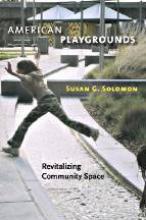
American Playgrounds, Revitalizing Community Space, has been called “a compelling history, a manifesto, and a manual for change.”1 Published in 2005 by the University Press of New England, Susan G. Solomon's perspective on American playgrounds came out of her own experiences with art, architecture, and sponsoring a playground in memory of her parents, Rita and Nathan Goldberg. In writing American Playgrounds, she sought “to combine a view of the past with a guide for anyone undertaking a similar commission in the future.”2
American Playgrounds begins with nearly 100 pages of history, broken down into two time periods: Pre-1960 and 1960-1995. Including the perspective of European influence, Susan outlines the beginnings of the American playgrounds and then contrasts those beginnings with the changes that emerged in the '60s and '70s. At that time a “risk aversion” mentality began to restrict the “imaginative abilities” of the professional architects, landscape architects, and sculptors.3 Susan maintains that well meaning safety standards by the U.S. Consumer Product Safety Commission (CPSC), the National Playground Safety Institute (NPSI), the ASTM International (ASTM), the International Play Equipment Manufacturers Association (IPEMA), and the Americans with Disabilities Act (ADA) resulted in the “homogenization of playground design” in an effort to sell an “unattainable idealism, a totally risk-free world.”4
The balance of the book deals with solutions for playgrounds which involve the interest of new patrons, emerging strategies for playground designs that depend less on manufactured equipment, and celebrations of unusual and unplanned play spaces. Each project spotlighted was selected because they enhanced community life, supported well-executed uncluttered design, and they echoed “the latest perspectives on play by providing for individual exploration, socialization, negotiation, fantasy, and gentle unexpected consequences.”5
The final chapter, Remedies, summarizes play space solutions by topic: laws and lawsuits, affordability and funding options, creative site locations, respect for play and “art form” play spaces, a new generation of professional playground designers, and the increasing opportunities for urban design and play that could be encouraged.6 Concerning American Playgrounds, Susan says, “I offer remedies that unite excellent design with innovative planning and affordable cost. My intention is to energize consumers to think broadly about what constitutes a good play environment. I encourage them to take action. It is time for the playground to become a critical element in public space.”7
American Playgrounds includes a forward by Martha Thorne, an Associate Curator of the Department of Architecture at the Art Institute of Chicago. She supports Susan's focus on urban design and maintains, “We should value the design of spaces for play as much as we value the children who use those spaces.”8
Through her heavily footnoted and annotated American Playgrounds, Susan is “powerfully optimistic that the current tide in American playground design will usher in a new age where … American playgrounds ... become extraordinary catalysts of cultural and social exchange that can shape American lives for the better.”9
- 1. “American Playgrounds.” University Press of New England. < http://www.upne.com/1-58465-517-8.html > 25 January 2011.
- 2. Solomon, Susan G. American Playgrounds, Revitalizing Community Space. By Solomon. Hanover and London: University Press of New England, 2005. p. xi.
- 3. Ibid. p. 44.
- 4. Ibid, p. 79-81.
- 5. Ibid. p. 2.
- 6. Ibid, p. 207.
- 7. “American Playgrounds.” American Playgrounds. < http://recentamericanplaygrounds.com/ > 25 Jan. 2011.
- 8. Op. cit., Solomon. Forward by Martha Thorne. p. ix.
- 9. Kushner, R. D. Review. American Playgrounds, Revitalizing Community Space, by Susan G. Solomon. University Press of New England. < http://www.upne.com/1-58465-517-8.html > 26 Jan. 2011.

